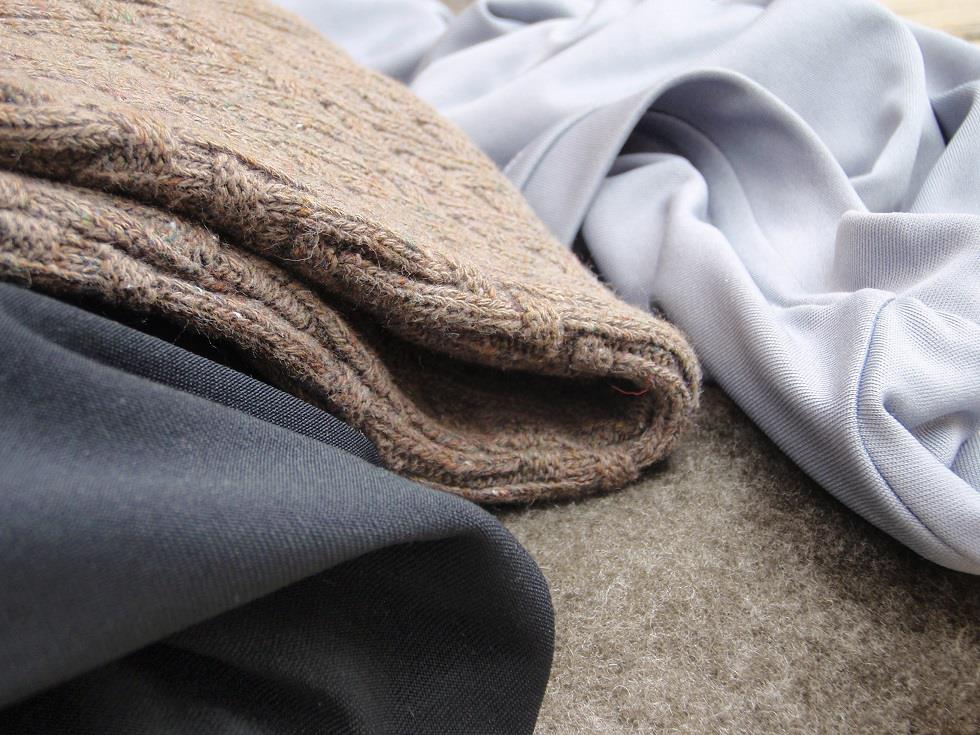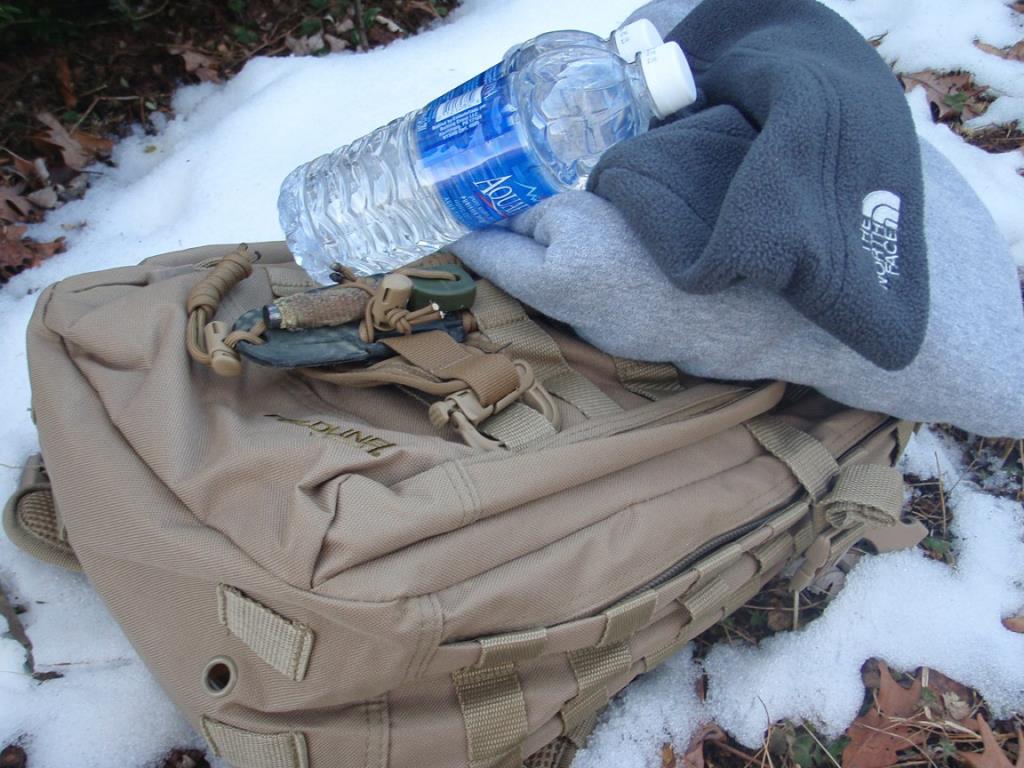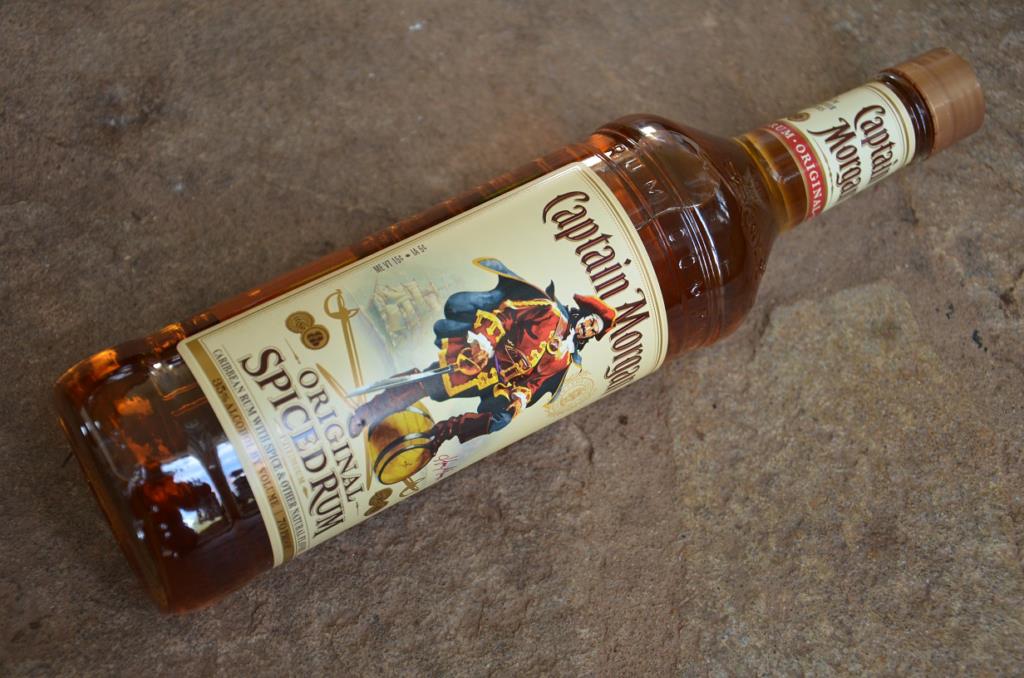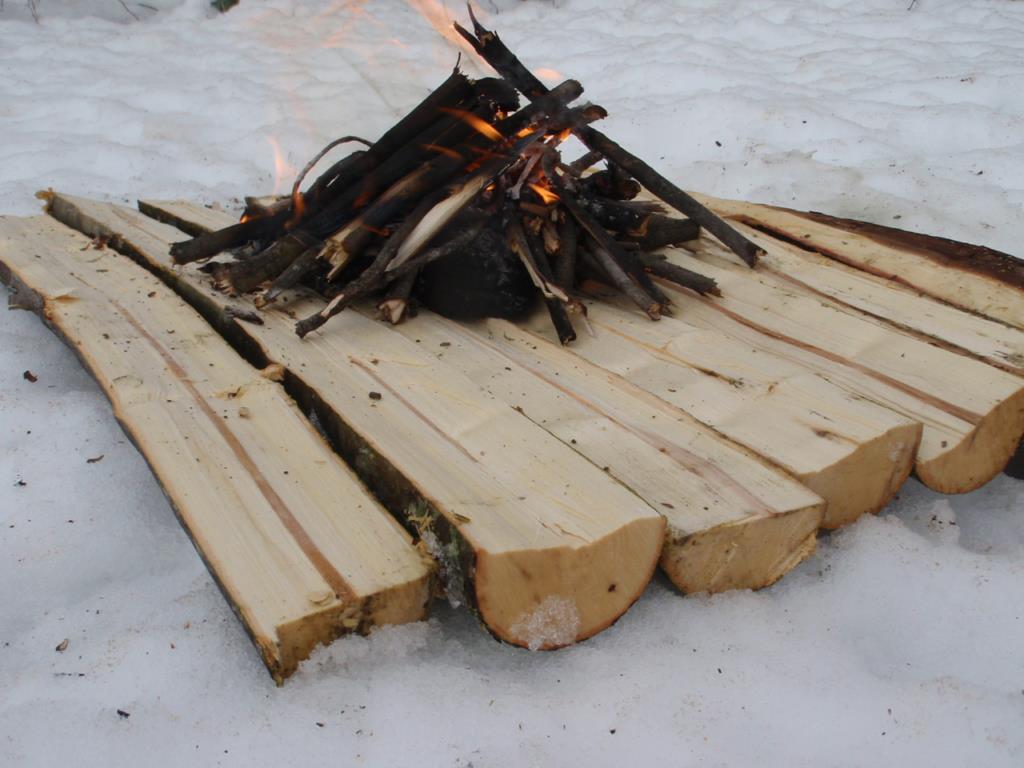Don’t build a fire directly on the snow. Tim MacWelch
We’ve been fighting against the cold since the dawn of humanity, and we’ve had plenty of time to devise strategies that allow us to survive in frigid weather. We’ve also had ample time to create falsehoods and gather misinformation about surviving the winter. Before you have to separate fact from fiction the hard way—getting stranded in a winter storm or buried by an avalanche—here are the 10 winter survival tips that everyone should know.
Without The Right Outdoor Clothing, You’re Doomed To Hypothermia

Clothing is our first line of shelter from the elements, but what happens when we get caught without the right garb? Tim MacWelch
The right clothes can make a big difference in the outdoors, not only for comfort but for survival. When the weather takes an unpredicted turn for the worse, and your clothing isn’t good enough, fall back on one of the oldest tricks of survival. Take a page from our Stone Age ancestors and stuff your garments with natural plant insulation. By scratching up any green materials and filling your clothing with them, you’ll create dead air space and feel warmer. Live or dead plants, such as grasses, moss, ferns, leaves and pine needles can be stuffed down pant legs and into shirts. Don’t worry about the materials being uncomfortable or containing bugs, they will. This isn’t done for comfort. You’ll feel and look silly, but be warmer. If that staves off hypothermia, it’s a fair trade.
Related: Best Winter Jackets
How to Treat Frostbite
It’s only natural to rub your hands together when they are cold, but this isn’t a wise thing to do when your tissues are suffering from frostbite. Rubbing frozen skin will not generate any useful amount of heat. Worse still, rubbing skin that contains ice crystals will only cause more tissue damage. As these sharp ice spikes move, they harpoon additional tissues and lead to worse damage than you’d receive by leaving the skin alone. The right treatment for this malady is gentle rewarming (if you can prevent additional freezing damage). Start by identifying the problem. Patches of mild frostbite will have a dull waxy appearance. Deeper frostbite will be pale and solid. Begin your rewarming by pre-treating with pain medication (frostbite is very painful once thawed). Ibuprofen is a good choice for the pain, and it should be taken before it gets too bad. Place the frostbitten tissues against warm skin or in warm water. The final steps are to protect the thawed tissue from refreezing and monitor the victim for hypothermia and shock.
Read Next: Best Winter Backpacks
You Can Get Dehydrated in Winter

Just because you’re not sweating much in cold weather, doesn’t mean you can’t become dehydrated. Tim MacWelch
In many regions, the winter air is dry. You may not notice any sweat because that moisture is evaporating quickly (or being absorbed by your clothes), but it’s a misconception to assume that “no sweat” equals “no dehydration”. Your skin tells the real story. Dry cracked skin on your hands, feet and lips are signs of the drying effect of low winter humidity. This painful side effect of dehydration can be prevented by paying attention to your hydration level. The easiest way to do this is to be aware of your urine output. If you’re not making some “yellow snow” every few hours, you’re dehydrated. Urine is the best gauge of hydration, as it takes into account your activity level, the air humidity, injury, illness and many other factors. Drink enough to pee your normal volume and frequency, and you’ll never have to worry about dehydration in any conditions.
Survive an Avalanche
Flatlanders who don’t travel will not have to worry about this one, but for those who step into an avalanche zone, it’s one of the scariest threats in snowy mountains. Getting caught in an avalanche may seem like the kind of situation you can’t survive, but a little preparation and knowledge can make all the difference. Here are three things that can save you on the snowy slopes.
Make sure that someone knows you’re out there. A responsible person (or two) should know where you are going, what your intended route will be and what time you should return. This isn’t just good advice in avalanche country, it’s a smart policy for all occasions.
Carry an avalanche beacon. This piece of gear can lead the searchers right to you. Learn how to use it and how to wear it before heading out there.
Swim for your life. Flowing snow doesn’t move exactly like water, but it moves in a similar way. When an avalanche starts underfoot, ditch your equipment (you can’t swim while holding onto skis, snowshoes or a snowmobile). Try to “swim” through the snow, while avoiding stationary things like trees and rocks. Thrust, kick and “swim” as hard as you can to stay on the surface of the snow. If you can’t stay on top of it, try to stay near the top and cover your face to create breathing space.
Drinking Booze Lowers Body Temp

Strong drink can cause a flush of warmth to our skin, but is this real warmth or a risky gambit? Tim MacWelch
At some point in your lifetime of watching cartoons, you’ve probably seen a Saint Bernard dog with a little cask of brandy hanging under his neck. This iconic image is based on real history. These rescue dogs did occasionally carry alcoholic spirits, but that doesn’t mean that drinking liquor in the intense cold is a good idea. The myth that sipping liquor will warm you up is a mistaken perception. Here’s a key winter survival tip: Alcohol can provide perceived warmth, as it clouds the pain of cold exposure and creates a flushed sensation by moving more blood to the skin. However, diverting blood flow away from the core and making you “feel” warmer is not as important as actually getting your body temperature to rise. This false warmth from bringing more blood to the surface will only cool your body more quickly. Instead of drinking booze, you should sip on a warm drink like hot cocoa, which provides both calories and heat in a chilly situation.
Survive Cold Water
An unlucky outdoor enthusiast slips into the frigid water and sinks under the surface. It may take the divers some time to find the victim in the dark water, but don’t give up on a cold water drowning victim. The treacherously cold water can actually send a drowning victim into a state of “suspended animation”. With all their systems slowed and chilled, brain damage is postponed and the cellular need for oxygen is diminished. Victims have been rescued and revived after being under water for as long as 40 minutes in near-freezing water. In this type of situation, never give up on resuscitation until the body has been completely rewarmed and is still unresponsive to treatment.
Read Next: Winter Survival Do’s And Don’ts
Don’t Warm Up Quickly With High Heat
Hot tubs and saunas are common fixtures around ski resorts and in cold climates, and it might seem like a good idea to drop someone in a Jacuzzi to rewarm them, but this exposure to high heat is not the right remedy for hypothermia. Immersion in hot water will not only be painful to the skin of the victim, the heat can send them into shock or even cause a heart attack. The right recipe is active external rewarming, administered by professionals. When that’s not an option, apply warm items around the victim’s body. Items like hot water bottles can be placed in the groin, both armpits and around the neck. Never drop the victim into a hot bath, set them in a steam room or treat them with any other kind of high heat exposure.
You Can’t Always Eat What the Animals Eat

The foraging can be scant in the colder months, but you need to be careful what you eat. Tim MacWelch
In the snow-covered landscape, a few stray berries may look like a banquet to a starving survivor. You may not be too sure about their identity, but the animals are chowing down on them. Does this mean that they are safe to eat? No way. Fellow mammals aren’t a safe role model for human foraging. Squirrels and deer routinely eat wild plants that would harm a human who mistakenly ingested them. Birds are an even worse animal to mimic. Their digestive system is quite alien to mammals, and they can safely gobble down an assortment of plants that would nourish us and murder us in the same feeding. If you want to learn which wild plants are people-food and which ones are toxic, you’ll have to do some earnest study and forget about the short cuts.
Getting You Truck Stuck in the Snow is Hazardous
It’s a mixed blessing when you get your vehicle stuck in the snow during a blizzard. On one hand, at least you have shelter from the storm. But on the other hand, the shelter comes with some serious hazards. All that metal makes for a very cold shelter, seeming to suck the body heat right out of the cabin in sub-freezing weather. There is an option for heating, and that is running the engine for warmth, but that has to potential to be a deadly decision. It can be helpful to start the vehicle to use the heater occasionally, but only do this if you’re 100 percent certain that you can keep the exhaust pipe open. If a vehicle tail pipe becomes buried by snow, slush, mud or water, exhaust can back up into the vehicle cabin and cause death from carbon monoxide poisoning. Yes, running vehicle engines has saved people from hypothermia in blizzard conditions, but it has also cost people their lives.
How to Light a Fire in the Snow

Don’t build a fire directly on the snow. Tim MacWelch
At some point in your outdoor adventures, you’ve probably tried to have a fire on top of the snow. If you tried it, everything started out normally. The tinder burned and the kindling lit. But as soon as the embers started to form, they dropped down into the snow and were immediately extinguished with a hiss. Then you learned the hard way—that a fire directly on the snow can’t last. Thankfully, you have options. If there’s a small amount of snow, dig down until you hit the frozen ground and build your fire there. When the snow is too deep for that, try option two, building a fire platform on top of the snow. The easiest way to crack this problem is to build a “raft” out of wood, to sit on top of the snow. This raft can be chunks of wet rotten wood, fresh cut live wood or anything in between. Place the pieces close together, eliminating gaps that would drop your embers down into the snow. Build and burn your fire atop this raft, just as you’d burn it on bare ground. Depending on the moisture in the log raft, it may last for one hour or for several hours. It can also be replaced, as needed.
Winter Survival Tips Dos and Don’ts
- DO take shelter for your most critical survival priority. Use insulation and supplemental heat sources as much as possible. This might mean ripping up the upholstery in your vehicle to use as insulation, or placing hot stones in the floorboards of the car to warm it. Whatever you deem necessary to live, do it.
- DON’T lose your shelter. Snow, fog, darkness, and other factors can make it hard to find your shelter again after you’ve left it to signal or scavenge. Mark the shelter with an improvised flag, something reflective or any other type of signal you have available. Not only will you be able to relocate your shelter more easily, your rescuers will have a better chance of finding it, too.
- DON’T sleep directly on the snow or frozen ground. Even in a snow cave, you still need something under you. Grab some evergreen boughs, tree bark, leaves, or anything else that can block the icy grip of cold surfaces.
- DO stay hydrated. Check your urine color and output as the most effective measure of hydration. If you haven’t urinated in many hours, and the color is dark yellow or amber, you are becoming dangerously dehydrated.
- DON’T eat ice or snow. While it is a viable source of liquid, it should never be consumed as a frozen solid. This will chill your body core and bring on hypothermia quickly. Instead, try placing the snow or ice in a bottle, and placing it under your coat, but not next to your skin. Body heat under your coat will liquefy the frozen stuff into water for safer consumption.
- DO carry fire-starting materials and several ignition sources during cold-weather travel. Lighters, matches, and spark rods are great choices. Carry Vaseline-soaked cotton balls, or fire starter packets to get cold, damp wood burning. Read next: Best Fire Starters.
- DON’T try to burn a fire in an open windy area, or directly on the snow. These are two recipes for disaster. If you must build fire in the open, build wind blocks. If building a fire over snow, cut some green wood to build a fire platform.
The post The 10 Best Winter Survival Tips appeared first on Outdoor Life.
Articles may contain affiliate links which enable us to share in the revenue of any purchases made.
By: Tim MacWelch
Title: The 10 Best Winter Survival Tips
Sourced From: www.outdoorlife.com/story/survival/survial-tips-to-get-you-through-winter/
Published Date: Fri, 27 Dec 2019 18:10:49 +0000
----------------------------------------------
Did you miss our previous article...
https://manstuffnews.com/weekend-warriors/biden-administration-bans-mining-near-minnesotas-boundary-waters-wilderness
 Backyard GrillingWeekend WarriorsAdvice from DadBeard GroomingTV Shows for Guys4x4 Off-Road CarsMens FashionSports NewsAncient Archeology World NewsPrivacy PolicyTerms And Conditions
Backyard GrillingWeekend WarriorsAdvice from DadBeard GroomingTV Shows for Guys4x4 Off-Road CarsMens FashionSports NewsAncient Archeology World NewsPrivacy PolicyTerms And Conditions
